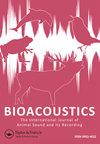Hurry up and sing: early onset of diel calling behaviour and ecological drivers of calling behaviour of Acanthoplus discoidalis
IF 2.1
4区 生物学
Q2 ZOOLOGY
Bioacoustics-The International Journal of Animal Sound and Its Recording
Pub Date : 2022-08-25
DOI:10.1080/09524622.2022.2112289
引用次数: 1
Abstract
ABSTRACT Animals adopt circadian rhythms and diel calling patterns to ensure successful breeding, avoid predators, and reduce intra- and inter-species competition. We determine the diel calling behaviour of the bush cricket, Acanthoplus discoidalis, across different vegetation types in the southern Kalahari, and whether any variation in calling behaviour exists across the different regions of the landscape. We identify potential environmental drivers impacting its calling behaviour, as well as any impact temperature and wind may have on the species’ calling behaviour. Acanthoplus discoidalis was recorded singing in all vegetation types, calling starts around 10h00 and ceases at 00h00, with a peak from 15h00 to 23h00, a longer peak than expected based on previous studies. This pattern was consistent across all vegetation types, although calling intensity was less in mountainous, rocky, and windy areas. A likely explanation for the expanded diel pattern is that sampling occurred during a mass emergence of the species, and so a wider temporal niche could be a response to reduce intraspecies competition for females. Furthermore, this diel calling pattern may reduce encounters with predators, which are typically either strictly nocturnal or diurnal, yet it is likely this species relies on physical defences over acoustic adaptations to avoid predation.快唱:盘棘鸣叫行为的早发性及生态驱动因素
动物采用昼夜节律和昼夜呼叫模式来确保成功繁殖,避免捕食者,减少物种内和物种间的竞争。我们确定了灌木蟋蟀(Acanthoplus discoidalis)在卡拉哈里南部不同植被类型中的叫声行为,以及叫声行为是否存在于不同地区的景观中。我们确定了影响其鸣叫行为的潜在环境驱动因素,以及温度和风可能对物种鸣叫行为的任何影响。Acanthoplus disidalis在所有植被类型中都有鸣叫的记录,鸣叫在10:00左右开始,0000左右停止,高峰在1500 - 2300之间,比以往的研究预期的要长。这种模式在所有植被类型中都是一致的,尽管山地、岩石和多风地区的呼叫强度较低。一个可能的解释是,采样发生在物种大规模出现期间,因此更宽的时间生态位可能是为了减少物种内对雌性的竞争。此外,这种昼夜鸣叫的模式可能会减少与捕食者的相遇,这些捕食者通常要么是严格的夜间活动,要么是白天活动,然而,这个物种很可能依靠身体防御而不是声音适应来避免捕食者。
本文章由计算机程序翻译,如有差异,请以英文原文为准。
求助全文
约1分钟内获得全文
求助全文
来源期刊
CiteScore
4.50
自引率
0.00%
发文量
25
审稿时长
>12 weeks
期刊介绍:
Bioacoustics primarily publishes high-quality original research papers and reviews on sound communication in birds, mammals, amphibians, reptiles, fish, insects and other invertebrates, including the following topics :
-Communication and related behaviour-
Sound production-
Hearing-
Ontogeny and learning-
Bioacoustics in taxonomy and systematics-
Impacts of noise-
Bioacoustics in environmental monitoring-
Identification techniques and applications-
Recording and analysis-
Equipment and techniques-
Ultrasound and infrasound-
Underwater sound-
Bioacoustical sound structures, patterns, variation and repertoires

 求助内容:
求助内容: 应助结果提醒方式:
应助结果提醒方式:


